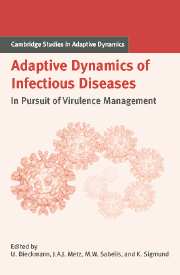Book contents
- Frontmatter
- Contents
- Contributing Authors
- List of Boxes
- Notational Standards
- 1 Introduction
- A Setting the Stage
- B Host Population Structure
- C Within-Host Interactions
- D Pathogen–Host Coevolution
- E Multilevel Selection
- F Vaccines and Drugs
- G Perspectives for Virulence Management
- Introduction to Part G
- 27 Taking Stock: Relating Theory to Experiment
- 28 Virulence Management in Humans
- 29 Virulence Management in Wildlife Populations
- 30 Virulence Management in Veterinary Epidemiology
- 31 Virulence Management in Plant–Pathogen Interactions
- 32 Virulence Management in Biocontrol Agents
- 33 Epilogue
- References
- Index
- International Institute for Applied Systems Analysis
Introduction to Part G
Published online by Cambridge University Press: 15 January 2010
- Frontmatter
- Contents
- Contributing Authors
- List of Boxes
- Notational Standards
- 1 Introduction
- A Setting the Stage
- B Host Population Structure
- C Within-Host Interactions
- D Pathogen–Host Coevolution
- E Multilevel Selection
- F Vaccines and Drugs
- G Perspectives for Virulence Management
- Introduction to Part G
- 27 Taking Stock: Relating Theory to Experiment
- 28 Virulence Management in Humans
- 29 Virulence Management in Wildlife Populations
- 30 Virulence Management in Veterinary Epidemiology
- 31 Virulence Management in Plant–Pathogen Interactions
- 32 Virulence Management in Biocontrol Agents
- 33 Epilogue
- References
- Index
- International Institute for Applied Systems Analysis
Summary
The authors of this book have been encouraged by the editors to stick their necks out and dream up strategies for virulence management, phrased as concretely as possible. As editors, we believe that good science proceeds by making definite predictions so that they can be rigorously put to the test. Phrasing predictions in the form of recommendations forces a healthy definitiveness; no one is allowed to hide under a slightly woolly phrasing. It must nevertheless be understood that not all the recommendations outlined here can as yet be taken at face value; many of the issues raised require additional theoretical and experimental research.
The stress on management aspects is the defining feature of this last part of the book. Whereas earlier parts review particular mechanisms of virulence evolution with a perspective on potentially ensuing options for virulence management, for this part of the book the authors were invited to focus on the following questions:
For which specific empirical settings can the various possible options of virulence management strategies be expected to apply?
For each given context, which options appear to be particularly promising?
What are the open research questions that have to be addressed before measures of virulence management can be recommended for implementation?
After an introductory chapter that is meant to summarize what has been achieved so far, each chapter in this part covers one of the main potential arenas for virulence management: human, wildlife, and livestock diseases, crop protection, and pest control.
- Type
- Chapter
- Information
- Adaptive Dynamics of Infectious DiseasesIn Pursuit of Virulence Management, pp. 376 - 378Publisher: Cambridge University PressPrint publication year: 2002



